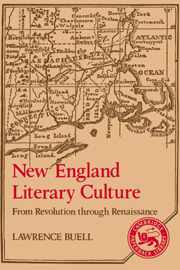Book contents
- Frontmatter
- Contents
- Acknowledgments
- Abbreviations of Frequently Cited Works
- PART I FOUR OVERVIEWS
- 1 Theoretical Premises
- 2 A Narrative Overview of New England's Literary Development
- 3 Marketplace, Ethos, Practice: The Antebellum Literary Situation
- 4 Neoclassical Continuities: The Early National Era and the New England Literary Tradition
- PART II THREE REPRESENTATIVE GENRES
- PART III REINVENTING PURITANISM: THE NEW ENGLAND HISTORICAL IMAGINATION
- Part IV NEW ENGLAND AS A COUNTRY OF THE IMAGINATION: THE SPIRIT OF PLACE
- Postscript
- Appendix Vital Statistics: A Quantitative Analysis of Authorship as a Profession in New England
- Notes
- Index
4 - Neoclassical Continuities: The Early National Era and the New England Literary Tradition
Published online by Cambridge University Press: 15 October 2009
- Frontmatter
- Contents
- Acknowledgments
- Abbreviations of Frequently Cited Works
- PART I FOUR OVERVIEWS
- 1 Theoretical Premises
- 2 A Narrative Overview of New England's Literary Development
- 3 Marketplace, Ethos, Practice: The Antebellum Literary Situation
- 4 Neoclassical Continuities: The Early National Era and the New England Literary Tradition
- PART II THREE REPRESENTATIVE GENRES
- PART III REINVENTING PURITANISM: THE NEW ENGLAND HISTORICAL IMAGINATION
- Part IV NEW ENGLAND AS A COUNTRY OF THE IMAGINATION: THE SPIRIT OF PLACE
- Postscript
- Appendix Vital Statistics: A Quantitative Analysis of Authorship as a Profession in New England
- Notes
- Index
Summary
Hail favour'd state! CONNECTICUT! thy name
Uncouth in song, too long conceal'd from fame;
If yet thy filial bards the gloom can pierce,
Shall rise and flourish in immortal verse.
Inventive genius, imitative pow'rs,
And, still more precious, common-sense, is ours;
While knowledge useful, more than science grand,
In rivulets still o'erspreads the smiling land.
David Humphreys, “A Poem on the Industry of the United States of America” (1804)Somehow the heroic couplet and the sweeping invocation did not fit the praise of the sober New England virtues.
Henry F. May, The Enlightenment in America (1976)Do the years between the Revolution and the Civil War really form a period in New England writing? So far this book has been transmitting mixed signals on the issue. Chapter 2 discussed the entire time span of this study in unitary terms as a movement toward literary self-realization, yet the partial correlations made in Chapter 3 between Romanticism and the rise of professionalism might suggest that we have here two disparate historical and aesthetic segments lumped together.
The notion of a sharp break between an early national or Federalist or Neoclassical period and an antebellum or Romantic period is not merely a scholarly retrospection but is also inherent in the later writers' conception of their historical moment. To antebellum New England authors outside the vicinity of Hartford and New Haven, the Connecticut Wits seemed quite as obsolete as the Puritan poets had seemed to the Wits.
- Type
- Chapter
- Information
- New England Literary CultureFrom Revolution through Renaissance, pp. 84 - 102Publisher: Cambridge University PressPrint publication year: 1986



